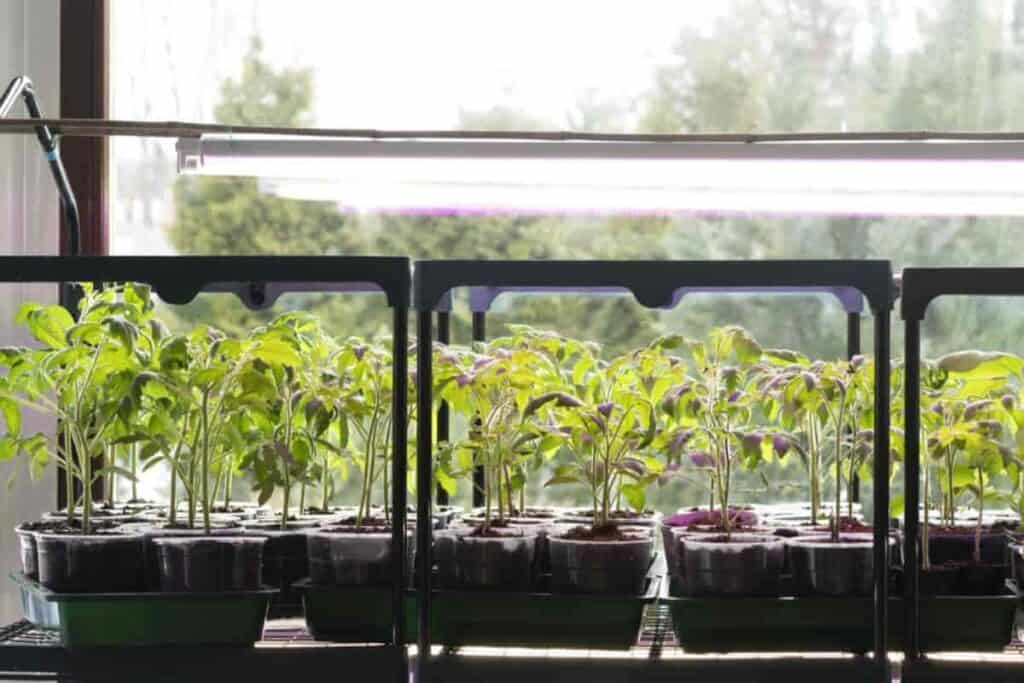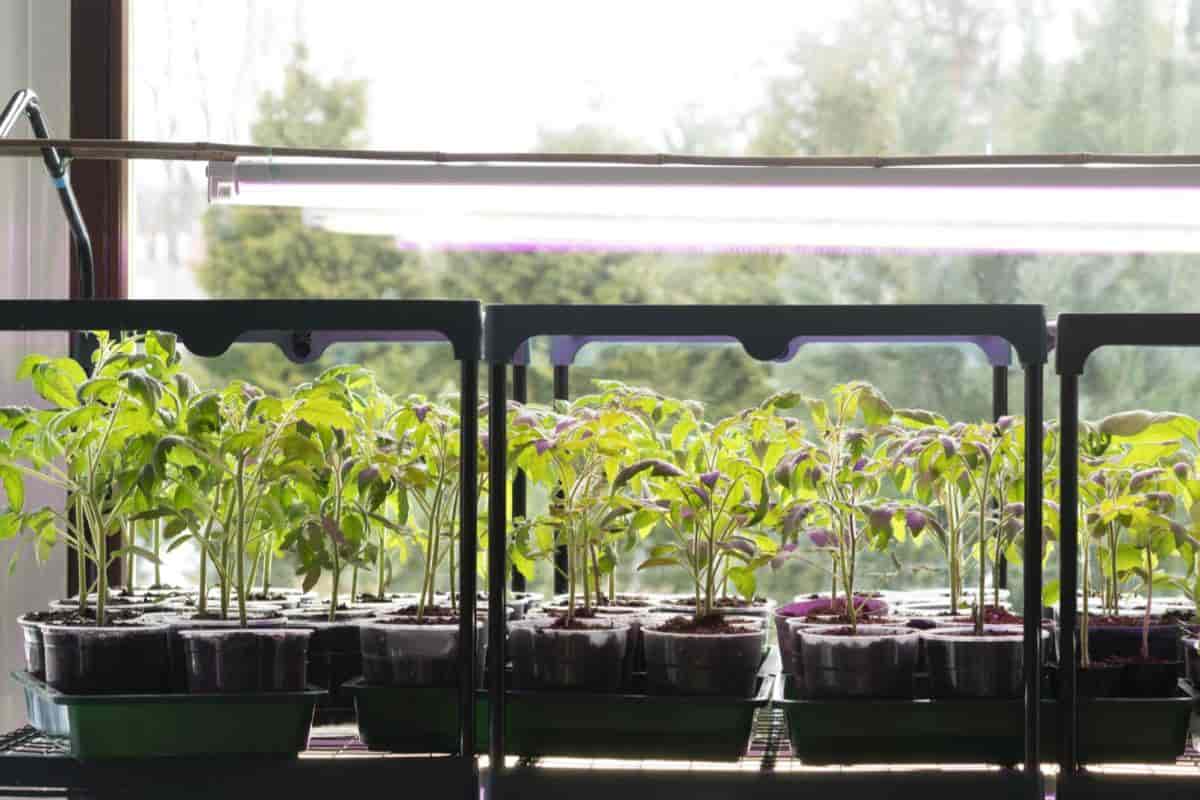More plants than window space! That’s the problem that confronts many indoor gardeners today. But it’s a problem which can be solved by using electric lights.

Electric Lights for House Plants
With properly installed and maintained fluorescent or incandescent light fixtures you can grow house plants in places you never thought possible—poorly lighted windows, and porches. bay windows, even totally dark basements.
I have been growing African violets successfully under fluorescent lights in my basement for several years.
Scientific Basis For Artificial Light
My testing and growing were purely bit-and-miss amateur endeavors, but at Boyce Thompson Institute, Yonkers, New York, and Ohio State University, Columbus, experiments have been conducted on a scientific basis.
In fact, at Boyce Thompson Institute, John M. Arthur and his associates have been experimenting with plant tinder artificial light since the institute was founded nearly 30 years ago.
Source of Light for Growing Plants
As each new type of electric light was developed it was tested as a source of light for growing plants. Tests have been conducted on such lights as;
- incandescent,
- neon,
- fluorescent,
- sodium vapor,
- mercury vapor, and
…combinations of various types.
Some of these are high-voltage fixtures demanding such intricate equipment that their use would be out of the realm of the average homeowner.
But research continues at the institute with the hope that soon light or a combination of lights will be developed to provide conditions suitable for growing all plants in the absence of sunlight.
Duplicating Sunlight
Duplicating sunlight is a difficult and expensive job. The sun provides heat energy as well as light, a fact most gardeners overlook, and this is, the reason why it is difficult to grow many plants under artificial light as a total substitute for sunlight.
Artificial Light as Sunlight
However, artificial light can be used to supplement sunlight on most. plants and as the sole ness for a certain number of hours each night to develop flower buds, would not be successful.
Plants that require little light for growth have shown the best results under artificial light, either as a supplement to sunlight or as the only source of light. Heading this list of plants are African violets and gloxinias.
Fluorescent Light: Best Artificial Light
Fluorescent lights have been found best for these. Although fluorescents do not give off as much light as other lamps, they give off enough for the purpose when kept on long enough.
They are easy to install, are relatively inexpensive to operate, and illuminate a fairly large area.
The exceptional results obtained by home gardeners have been confirmed scientifically by tests at Ohio State University. some of which were conducted with funds provided by the African Violet Society of America.
African Violets Grow Under Fluorescent Light
At Ohio State, it was found that African violets grown under fluorescent lights were equal to and in some cases better than titan plants grown in a greenhouse.
The average number of flower stalks per plant was greater as was the average number of flowers per plant. Also. the plants developed faster, were larger and the leaves extremely dark in color.
The tests were made under various light intensities—measured in foot-candles ff.e.—kept on 6, 12, and 18 hours each day.
The basement-grown plants under fluorescent lights were compared to plants grown in a shaded greenhouse.
Light Readings for Best Results
The light readings were taken throughout the day and shade was applied or removed periodically to keep the reading us. close as possible to the desired intensity.
Best results under fluorescent light were obtained with 600 f.c. of light burning continuously for 18 hours a day.
Good results were also obtained with 300 Lc. at 18 hours a day, and this the home gardener can duplicate very easily in his own basement by using a two-tube 40-watt fixture with daylight or cool white bulbs.
This will light a growing area of 2 1/2 by 4 ft. Such a fixture costs between $12.00 and $15.00 and in the New York area, the cost of electricity would be approximately $1.00 per month – kept on 18 hours a day.
Heavy Light Fixtures
Since the light fixtures are rather heavy they are best suspended by a chain from sturdy support – mine are hung from the beams.
By using a chain you can also raise or lower the lights so they are always 1 ft above the plants. the distance necessary to provide the 300 Lc. required.
Fluorescent lights are cool lights and give off a negligible amount of heat. Therefore. the basement or room where the African violets are to be grown should be the proper temperature for growth – no lower than 60° to 62° at night.
Basement Fluorescent Setup
Many innovations can be incorporated into a basement fluorescent setup. An electric time switch such as used in chicken brooders could be used to automatically turn lights on and off at the proper time.
In the summer, an exhaust fan in one window might be necessary to provide ventilation as African violets do not like stagnant air.
When a fairly large set-up is planned, it might be wise to consult an electrician to see that there is no possibility of overloading a circuit or outlet.
Growing African Violets
No special culture is needed for growing African violets under fluorescent light in the basement.
The plants will have lush deep green leaves and good flowers with the same care you give plants in the window.
In my own set-up, I keep my plants on benches covered with a ½”-inch layer of moist peat moss which I find helps keep the plants from trying out too quickly.
All the plants are in clay pots which are watered from the top by hose with lukewarm waterfront the tap in the wash tub.
Leaves Are Less Apt
Since the light from fluorescents is not as strong as sunlight. the leaves are less apt to spot when wet.
In fact. I often sprinkle the leaves with a fine spray – tepid water, of course – to help freshen the plant, especially in the hot summer.
I feed my plants soluble plant food every two weeks. The easiest way I found to use this type of fertilizer is with a dispenser attached right to the hose.
Fluorescent Lights: Good Advantage
Fluorescent lights can also be used to good advantage as a supplement to natural light for African violets.
Many porches have a dark side which could be rigged up with a light fixture; or, a north window suitable for plants only in summer could be fined with shelves and a fixture over each for good growing conditions throughout the year.
Natural Light
In such cases, natural light will be sufficient for part of the day during summer and the lights are needed only in the afternoon and evening.
In winter, however, it may be necessary to keep the lights on for the full 18 hours each day. A fixture in the basement could also be a source for upstairs window plants.
I grow my gloxinias in the basement until the buds are just about to open and then bring them upstairs so they can be enjoyed to the best advantage. After a plant has passed its prime there’s usually another downstairs to take its place.
Propagation Using Fluroscent Light
Another excellent use for fluorescent lights is propagation. Although my own “incubator” was designed for starting African violet leaves, I have successfully rooted many other soft plants as well as woody broadleaf evergreens.
There is sufficient light for rooting but not enough for growing plants on. As soon as roots are formed the cuttings are best removed to a coldframe, greenhouse, or garden for growing on.
Indoor Gardening: Artificial Light
Artificial light, although no substitute for sunlight, does have its place in today’s indoor gardening as a supplement to natural light and also as a total source of light for sonic plants.
As research continues and newer electrical fixtures developed there may come a day when the light will not be the limiting factor in growing house plants as it is in many homes today.
44659 by William L. Meachem
